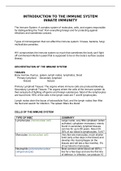INTRODUCTION TO THE IMMUNE SYSTEM
INNATE IMMUNITY
The Immune System: A complex system of molecules, cells, and organs responsible
for distinguishing the “host” from everything foreign and for protecting against
infections and sometimes cancers.
Types of microorganism that can affect the immune system: Viruses, bacteria, fungi,
multicellular parasites.
HIV compromises the immune system so much that sometimes the body can’t fight
off commensal infection (yeast that is supposed to be on the body’s surface causes
illness).
ORCHESTRATION OF THE IMMUNE SYSTEM
TISSUES
Bone marrow, thymus, spleen, lymph nodes, lymphatics, blood
Primary lymphoid Secondary lymphoid
tissues tissues
Primary Lymphoid Tissues: The organs where immune cells are produced/develop.
Secondary Lymphoid Tissues: The organs where the cells of the immune system do
their actual job of fighting off germs and foreign substances. Most of the lymphocytes
are found here. 95% of the cells in the lymph node are T and B lymphocytes.
Lymph nodes drain the tissue of extracellular fluid, and the lymph nodes then filter
the fluid and search for infection. The spleen filters the blood.
CELLS OF THE IMMUNE SYSTEM
TYPE OF WBC SUMMARY
Lymphocytes (mononuclear cell) Large nuclei, very little cytoplasm (when
activated, cytoplasm increases), mainly
found in secondary lymphoid tissues,
can live for up to 80 years. About 25-
30% of our blood is lymphocytes. 1x1012
Monocytes (mononuclear cell) Very few are monocytes, much shorter
lived (only a few days in the blood) and
develop into macrophages (in the
tissues and will last a few months). 5%
of our blood is monocytes.
Neutrophils (polymorphonuclear Most common white blood cell (65%),
cell/granulocyte) live for a few days and are the first line
of defence. In infection, we produce 10
, times the amount. They eat one
bacterium and die. Pus is dying
neutrophils. Neutrophils stain with
neutrophilic dyes.
Eosinophils (polymorphonuclear Much less common, (5%) Eosinophils
cell/granulocyte) stain with eosinophilic dyes.
Basophils (polymorphonuclear Blood mast cells. In the blood they’re
cell/granulocyte) basophils and in the tissue, they’re mast
cells. Basophils stain with basophilic
dyes.
Mast cells
Macrophages
Dendritic cells There is minority population of dendritic
cells in lymph nodes which are also
found in any part of the body that
encounters foreign substances from the
external environment (e.g., skin, lungs,
gut, spleen. They present antigen
foreign molecules to the T lymphocyte.
In the tissues, immune cells are found even when there is no current infection. The
first cells to appear when there is an infection are neutrophils, T lymphocytes and
macrophages.




